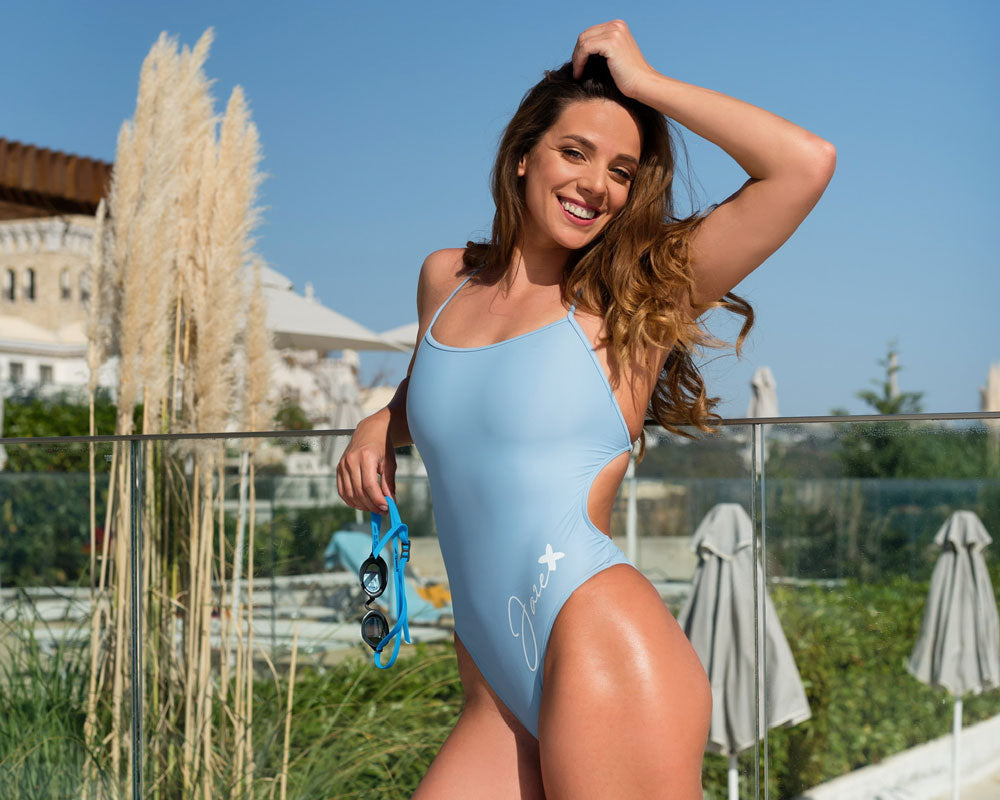Key Takeaways:
|
Are you looking for a unique way to supercharge your muscle building journey? Look no further than swimming. Yes, you read that right. Swimming is not just a fun summertime activity; it can also be a powerful tool in building lean muscle and sculpting your physique.
Unlike traditional weightlifting exercises, swimming engages multiple muscle groups simultaneously, resulting in a full-body workout that helps you unlock your true potential. From your arms and shoulders to your core and legs, every stroke you take in the water activates and strengthens various muscles. Not only does swimming help you build muscle, but it also improves your cardiovascular endurance, flexibility, and overall body composition. Plus, it's a low-impact exercise, making it ideal for individuals with joint issues or those looking for a break from high-intensity workouts.
So, if you're ready to take your fitness journey to the next level, dive into the pool and discover how swimming can propel your muscle building progress. Get ready to unleash your full potential in and out of the water.
As you swim regularly, your muscles adapt to the unique stresses of the water, leading to increased size and strength.
The science behind swimming and muscle growth
Swimming is a unique form of exercise that combines resistance training with cardiovascular conditioning. When you swim, your body works against the natural resistance of water, which is approximately 800 times denser than air. This resistance creates a challenging environment for muscle engagement, forcing your muscles to adapt and grow stronger over time. The buoyancy of water also provides support, allowing you to perform movements without the same level of impact associated with land-based workouts. This duality makes swimming an excellent option for building muscle while minimizing the risk of injury.
Moreover, swimming stimulates muscle hypertrophy through a variety of strokes that engage different muscle groups. Each stroke, whether it’s freestyle, breaststroke, backstroke or butterfly, targets specific muscles in the body. For instance, freestyle primarily works the shoulders, back, and core, whereas butterfly engages the chest and arms intensely. This multifaceted approach ensures that multiple muscle groups are activated concurrently, promoting balanced development and strength throughout the body. As you swim regularly, your muscles adapt to the unique stresses of the water, leading to increased size and strength.
Additionally, swimming improves muscle endurance, which is crucial for athletes and fitness enthusiasts alike. The continuous nature of swimming means that muscles are engaged for extended periods, enhancing their endurance capacity. This increased endurance not only contributes to better performance in the pool but also translates to improved stamina during other forms of exercise. By incorporating swimming into your routine, you can develop a solid foundation of muscle strength and endurance, setting the stage for greater overall physical performance.
Swimming engages muscles all over the body, leading to improved muscle tone and definition.
Benefits of swimming for muscle building
Swimming offers a plethora of benefits that make it an exceptional choice for those looking to build muscle. One of the most significant advantages is its ability to provide a full-body workout. Unlike many traditional exercises that focus on specific muscle groups, swimming engages muscles all over the body, leading to improved muscle tone and definition. This comprehensive engagement is particularly beneficial for individuals looking to achieve a balanced physique, as swimming helps develop both upper and lower body strength simultaneously.
Another key benefit of swimming is its low-impact nature. For those who may struggle with joint pain or injuries, swimming presents a safe alternative to high-impact workouts. The water's buoyancy reduces the stress placed on joints, allowing individuals to work out effectively without the risk of aggravating existing injuries. This aspect makes swimming an appealing option for people of all ages and fitness levels, from beginners to seasoned athletes.
In addition to muscle building, swimming enhances cardiovascular fitness. The aerobic nature of swimming helps improve heart health and lung capacity, promoting better blood circulation and oxygen delivery to muscles. This increased cardiovascular efficiency supports prolonged exercise sessions, allowing you to swim longer and push harder, ultimately contributing to muscle growth and endurance. The combination of strength training and aerobic conditioning that swimming provides makes it an unparalleled exercise choice for those serious about their fitness journey.
Different swimming strokes can be tailored to target specific muscle groups, making it essential to incorporate a variety of strokes into your swimming routine.
Swimming strokes for muscle development
Different swimming strokes can be tailored to target specific muscle groups, making it essential to incorporate a variety of strokes into your swimming routine. Freestyle, or front crawl, is one of the most popular strokes and is excellent for building upper body strength. It primarily engages the shoulders, triceps, and core while also working the legs and hips. The continuous motion required in freestyle helps develop both strength and endurance in these muscle groups, making it a fundamental stroke for muscle development.
Another stroke to consider is the breaststroke, which is particularly effective for developing the chest, shoulders and legs. The unique arm movement in breaststroke involves a circular motion that engages the pectoral muscles deeply. Additionally, the powerful kick used in this stroke targets the quadriceps and hamstrings, promoting muscular balance in the lower body. Incorporating breaststroke into your routine can help build a well-rounded physique, especially if combined with other strokes.
Backstroke is often overlooked but is equally beneficial for muscle development. This stroke works the back muscles, particularly the latissimus dorsi, while also engaging the shoulders and core. The position of the body in the water during backstroke promotes spinal alignment and stability, which can enhance overall muscle function. Lastly, the butterfly stroke, known for its intensity, engages the chest, arms, and core muscles significantly. Its demanding nature challenges both strength and endurance, making it a powerful addition to any muscle-building swimming routine.
Ideally, aim for at least two to three swimming sessions per week, allowing for adequate recovery between workouts.
Incorporating swimming into your workout routine
To reap the full benefits of swimming for muscle building, it's essential to incorporate it strategically into your workout routine. Start by determining how many days a week you can dedicate to swimming. Ideally, aim for at least two to three swimming sessions per week, allowing for adequate recovery between workouts. This frequency will enable your body to adapt to the new demands placed on it while providing enough stimulus for muscle growth.
When structuring your swimming workouts, consider varying the intensity and duration. Begin with shorter sessions of around 20-30 minutes, focusing on technique and building familiarity with different strokes. As you progress, gradually increase the duration and include interval training to enhance both strength and cardiovascular fitness. For example, alternate between sprinting for a set distance and swimming at a moderate pace. This approach not only keeps your workouts engaging but also maximizes muscle engagement and growth.
In addition to swimming, it’s beneficial to maintain a balanced workout routine that includes strength training and flexibility exercises. Incorporate resistance training sessions targeting major muscle groups on non-swimming days. This combination will help improve overall muscle strength and performance in the water. Remember to also include stretching and mobility work to enhance flexibility, which is crucial for effective swimming and preventing injuries.
Preparing for a swimming workout
Preparation is key to maximizing your swimming workouts and ensuring that you are ready to train effectively. Start by selecting the appropriate swim gear, including a comfortable swimsuit, goggles and swim cap. Proper-fitting swimwear can enhance your performance by reducing drag, while goggles protect your eyes and allow you to see clearly underwater. A swim cap can also help maintain your hair and streamline your movements in the water.
Before jumping into the pool, it’s essential to warm up your muscles to prevent injury and enhance performance. Engage in dynamic stretching and mobility exercises that target the major muscle groups used in swimming. Focus on your shoulders, arms, back and legs to prepare them for the rigorous demands of your workout. Consider doing some light aerobic activity, such as jogging or jumping jacks, for a few minutes to elevate your heart rate and increase blood flow to your muscles.
Once you’re in the pool, start with some easy laps to acclimate your body to the water. Gradually increase the intensity and incorporate drills specific to your swimming goals. For instance, if your focus is on building strength, include sets that emphasize resistance, such as using swim paddles or fins. A proper warm-up routine sets the stage for a successful workout, helping you make the most of your time in the pool.
Don’t forget the importance of recovery in your muscle-building journey.
Tips for maximizing muscle building during swimming sessions
To truly maximize muscle building during your swimming sessions, consider incorporating several strategies that enhance both performance and recovery. One effective method is to focus on your stroke technique. Efficient swimming involves proper body positioning and movement patterns that reduce drag and promote effective muscle engagement. Consider working with a swim coach or using video analysis to assess and improve your technique. This investment can lead to better performance and more significant muscle gains.
Another vital tip is to vary your workouts by incorporating different training techniques. Use interval training, which alternates between high-intensity sprints and moderate-paced swimming. This approach not only boosts cardiovascular fitness but also challenges your muscles in new ways, promoting growth. Additionally, consider adding resistance tools, such as swim bands, paddles or a pull buoy, to create more resistance and stimulate muscle development during your sessions.
Don’t forget the importance of recovery in your muscle-building journey. After each swim workout, prioritize post-exercise recovery strategies such as stretching, foam rolling and hydration. Stretching helps maintain flexibility and reduces muscle tightness, while foam rolling can alleviate soreness and improve blood flow. Hydration is crucial for muscle recovery, so ensure you’re drinking enough water before, during and after your swim. By focusing on recovery, you’ll set your body up for success and allow your muscles to repair and grow stronger.
Incorporate interval training, drills and resistance tools to keep your workouts fresh and challenging.
Common mistakes to avoid while swimming for muscle building
While swimming is an excellent way to build muscle, there are common mistakes that can hinder your progress. One of the most prevalent errors is neglecting proper technique. Poor stroke mechanics can lead to inefficient movements, which not only reduces the effectiveness of your workout but also increases the risk of injury. Take the time to learn and practice the correct techniques for each stroke and consider seeking guidance from a coach to help refine your skills.
Embrace the water as your new training ground and watch as your muscles grow, your endurance improves and your overall health flourishes.
Conclusion: Embrace the power of swimming for muscle growth
Embracing swimming as a key component of your muscle building journey can yield remarkable results. The unique combination of resistance training, cardiovascular conditioning and low-impact exercise makes swimming an ideal activity for those looking to enhance their physique and overall fitness. By understanding the science behind swimming and its benefits for muscle growth, as well as incorporating various strokes and techniques, you can unlock your potential in the pool.
We hope you enjoy your next swimming session.




